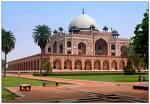The UNESCO approved World Heritage Tomb of Humayun is the best example of Mughal architecture at Delhi . Humayun, was the second emperor of the Mughal dynasty and he inspired several major architectural innovations, culminating with the construction of the Taj Mahal.
The first substantial example of a garden tomb on the 'charbagh' pattern with high arches and double dome was erected by Humayun's queen Hamida Banu Begam (Haji Begam) in AD 1570 at cost of 15 lakh rupees (1.5 million). The lofty mausoleum is in the centre of the enclosure and rises from a podium faced with series of cells having arched openings. The central octagonal chamber contains the cenotaph, encompassed by octagonal chambers at the diagonals and arched lobbies on the side. Their openings are closed with perforated screens. Each side is dominated by three arches, the central one being the highest. This plan is repeated on the second storey too. The roof surmounted by a double dome (42.5m) of marble has pillared kiosks (chhatris) placed around it.
The high rubble built enclosure is entered through two lofty double-storeyed gateways on the west and south. A baradari (pavilion) occupies the centre of the eastern wall and a hammam (bath chamber) in the centre of northern wall.
Several rulers of the Mughal dynasty lie buried here. Bahadur Shah Zafar had taken refuge in this tomb with three princes during the first war Independence (AD 1857).
On the southwestern side of the tomb is located barber's tomb (Nai-ka-Gumbad) which stands on a raised platform, reached by seven steps from the south. The building is square on plan and consists of a single compartment covered with a double-dome. |
